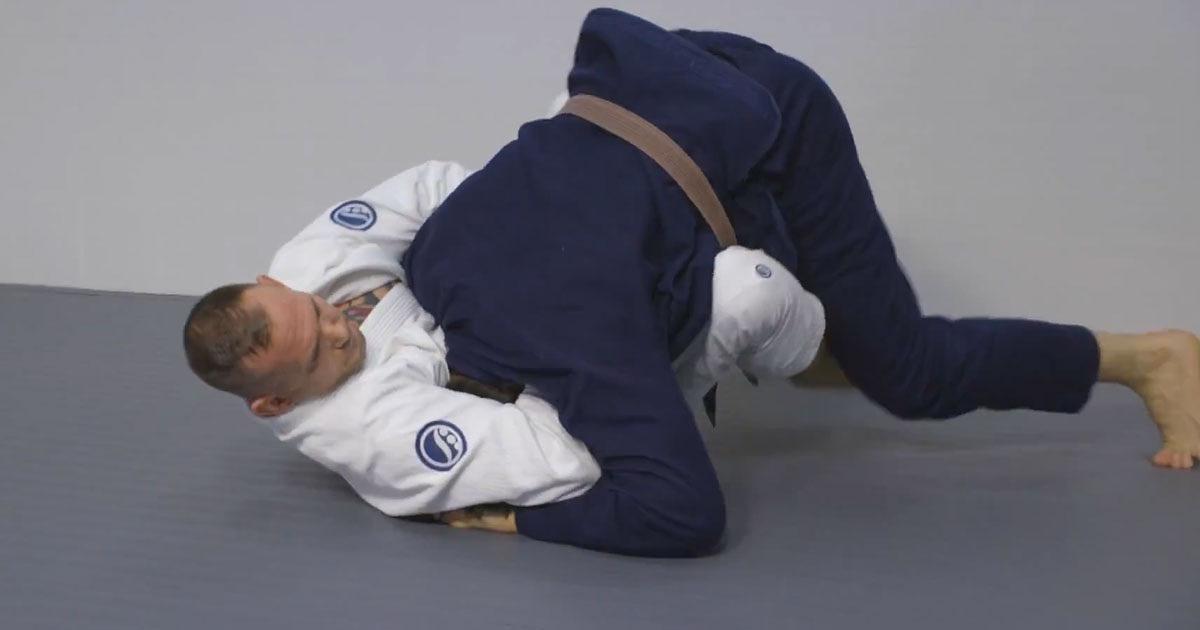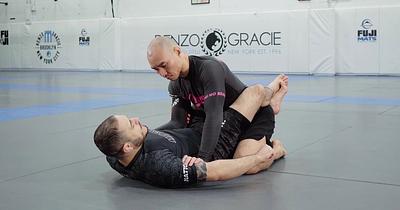Guillotine Choke Fundamentals
by Team Digitsu
Updated: March 24, 2025

The Guillotine Choke is an essential technique in Brazilian Jiu-Jitsu (BJJ) that you'll find effective not only in this martial art but also in mixed martial arts and self-defense scenarios. It's a submission maneuver that focuses on grappling, where you apply pressure on your opponent's neck using your arms. As you sink this choke in, you affect either the carotid arteries, obstructing blood flow, or the trachea, obstructing air to submit your opponent.
Understanding the intricacies of this move enables you to expand your BJJ arsenal significantly. In practical terms, the Guillotine can be applied from various positions, making it a versatile option in your repertoire. While it may appear straightforward at first - encircle the neck, grip, and squeeze - the effectiveness largely depends on the nuances of your technique, such as the grip, position, angle, and timing.
With consistent practice and attention to detail, you can refine your Guillotine to make it a reliable submission in competitions or as a self-defense tool. Remember that like any martial arts technique, mastering the Guillotine takes time and patience, and it's as much about the subtleties of your movement as it is about the overall strength you exert.
Fundamentals of Guillotine BJJ
The Guillotine Choke is a powerful submission in that requires proper technique and an understanding of the mechanics behind the choke. Mastery of this move can significantly elevate your grappling game.
Understanding the Guillotine Choke
Your objective when applying a Guillotine Choke is to create a loop around your opponent's neck using your arms, which then allows you to apply pressure primarily to their trachea or carotid arteries. This can be executed as an Air Choke if you compress the trachea, or a Blood Choke by squeezing the carotid arteries, interrupting blood flow to the brain. Achieving control over your opponent's head and positioning is crucial; this dominance can either facilitate a quick submission or serve as a transition point for additional maneuvers.
Mechanics of Execution
When you go for the Guillotine Choke, it's essential that you lock your grip correctly to ensure maximal pressure. Techniques vary, but common grips include the arm-in guillotine or the high elbow variation, which can redirect even more pressure on the neck.
- Control: Secure your opponent's head beneath your armpit, wrap your arm around their neck.
- Positioning: Angle your body to the side of the arm that's executing the choke, ensuring leverage.
- Pressure: Apply upward compression by contracting your arm and chest, targeting the neck.
- Submission: Complete the choke by maintaining the pressure, often leading your opponent to tap out.
Keep your grip snug and your body positioned in such a way to maximize leverage—details about optimal grip types and submission strategies can be found in guides such as Understanding the Guillotine Choke. Remember, the key to a successful guillotine is the balance between Control, Pressure, and Leverage.
Positioning and Control
Establishing a dominant position and maintaining precise control are essential elements in executing an effective guillotine choke. Mastering guard variations also plays a critical role in both offensive and defensive maneuvers.
Establishing Dominant Position
To secure a guillotine choke, determine your position relative to your opponent—typically aiming for top position or a dominant guard. The pressure applied through your hips, the angle at which you attack, and the ability to control your opponent's head and arm with your arm are critical. A higher hip position dictates the level of control and the feasibility to finish the choke. Ensure you have the correct angle by adjusting your body; a slight hip movement might increase efficiency.
Guard Variations and Their Roles
The role of guard variations in executing a guillotine can't be overstated. If operating from a closed guard, focus on trapping your opponent's body to limit their ability to escape. Use your legs actively to break their posture. When in half guard, pay attention to preventing your opponent from passing. Full Guard offers the most control, allowing you to break their posture down and set up a tight choke. Within bottom position, your guard acts as both defense against strikes and a launching pad for submissions. Always be mindful of your hip movement; it's the pivot point that enables you to secure and maintain these positions.
Executing from Different Guards
The guillotine choke is a powerful submission that varies in application depending on your guard position. Mastering the guillotine from different guards enhances your attacking versatility and can catch your opponents off guard.
Closed Guard Guillotine
When you have your opponent in Closed Guard, you're in an excellent position for a guillotine choke. Focus on gaining a deep grip on your opponent's neck, using your arm like a noose. The key here is to cut an angle, shifting your hip out to the side rather than pulling straight back.
Butterfly Guard Guillotine
From the Butterfly Guard, the guillotine can be quite dynamic due to your ability to elevate and shift your opponent using your legs. Once you trap the head and establish your grip, use a combination of elevating with your butterfly hooks and crunching towards the angle where their head is trapped. This ensures a tight choke and limits their capacity to escape or posture up.
Half Guard Guillotine
The Half Guard is often seen as a defensive position, but it is also an unexpected place to launch a guillotine attack. Secure your grip under the chin as soon as you see an opening, then use your legs to control their body and prevent the pass. To finish the submission, you need to either get to your side or create enough angle with your upper body. The correct execution from half guard is crucial for an effective choke.
Transition and Escapes
Mastering the transitions to advanced positions and escape techniques is essential. Your ability to transition effectively can mean the difference between maintaining control or being submitted. Similarly, understanding escape techniques can help you recover from a disadvantageous position and reset the fight.
Escape Techniques
Escaping a Guillotine Choke involves a combination of techniques tailored to the situation you find yourself in. Firstly, to relieve pressure on your neck, use your hand on the choke side to create space. If your opponent has closed guard, you should look to sprawl to reduce their leverage. One specific technique is the 'Single Leg Escape'—from a standing position with a deep guillotine applied, drop down to one knee while grabbing your opponent's leg to disrupt their balance and escape the choke.
Remember to stay calm, focus on controlling your opponent's wrists or arms to prevent them from tightening their grip, and create the necessary space to breathe and plan your next move. Your goal is to reset the position, regain control, and work your way back to a more advantageous spot.
Standing Guillotine Mastery
Mastering the standing guillotine choke requires technical knowledge of entries and setups, along with the ability to execute with precision. As well as in disciplines like wrestling, judo, and MMA, this choke is a powerful submission that can be applied from a standing position.
Entries and Setups
When you want to enter into a standing guillotine, positioning is key. Aim to secure a collar tie, which involves gripping the back of the opponent's neck with one hand while your other hand controls their arm or wrist. This control can prevent their escape and creates an opening for the choke.
For a chinstrap entry, you'll capitalize on moments where your opponent's head is low. You can snap their head down from a collar tie and quickly switch to a chinstrap grip, cupping their chin with the blade of your wrist. Remember that the effectiveness of your setups often comes down to speed and surprise; be agile and make your movements count.
Executing the Standing Guillotine Choke
To properly execute the choke, quickly loop your free arm under your opponent's chin and over their shoulder. Ensure your grip is snug, with the chinstrap grip secure, aiming to place your forearm against their windpipe. The goal here is to create a seal around their neck, leaving little to no space for escape.
Once you have your grips, apply upward pressure to the chin and downward pressure with your shoulder to intensify the choke. It's crucial that your elbows are close to your body to maximize the choke's force. Use your hips and legs to generate additional leverage; often a slight hip out combined with a downwards angle can increase the pressure.
By honing these tactics, you can turn the standing guillotine into a reliable and formidable weapon in your grappling arsenal. Remember, its success lies in the details of your grip and your ability to control your opponent's posture throughout the setup and execution.
Variations and Grips
Mastering the subtle intricacies of guillotine chokes, including various grips and setups, can significantly enhance your submission arsenal. Whether you favor no-gi or gi grappling, understanding the differences in these variations is crucial.
Arm-In Guillotine
The Arm-In Guillotine is a potent variation where you entrap your opponent’s head and one arm within your choking grip. This requires a precise setup with your arm positioned under the opponent’s chin and your forearm pressing against their trapped arm. Grip variations for this choke include the gable grip or the palm-to-palm method.
-
Grip Technique:
- Gable Grip: Clasp your hands together without interlocking your fingers.
- Palm-to-Palm: Place one palm against the other, aligning your thumbs side by side.
One effective approach for this hold involves keeping your choking arm's elbow high on your chest, creating significant pressure on the neck and arm.
No-Gi Variations
In no-gi BJJ, the absence of the gi demands greater emphasis on grip strength and precision. The guillotine chokes are no exception. A variation you might encounter is the Marcelotine, a form of guillotine applied with a high elbow.
-
Key Points:
- Utilize the high-elbow configuration to minimize your opponent's escape routes.
- Focus on wrist detail, where a slight wrist twist can increase choke tightness.
High-Elbow Guillotine
The High-Elbow Guillotine amplifies the traditional choke's efficacy by positioning your choking arm's elbow upward, creating additional leverage. This variation is renowned for its finishing ability, described as finishing either with the high elbow or the Rafa-style guillotine.
-
Execution Tips:
- Keep your wrist against the opponent's throat, positioning it for optimal pressure.
- Lift your elbow up as if aiming to touch it to the ceiling, which helps to tighten the choke.
Understanding these nuances and committing to perfecting each grip and variation will bolster both your offensive and defensive game.
Defense Against Guillotine Chokes
Mastering the defense against guillotine chokes is essential for your progress. Proper technique and understanding of defense mechanisms will not only help you escape but also prevent the submission.
Preventing the Guillotine
- Awareness of Position: Always be conscious of your head placement. Keeping your head up and chin tucked can reduce the risk of your opponent securing a guillotine choke.
- Control the Distance: Use your arms to create a barrier and control the space between you and your opponent, making it harder for them to initiate the choke.
CounterMoves and Defenses
- Hand Fighting: Once the choke is attempted, immediate hand fighting to control your opponent’s gripping hand is crucial.
-
Escape Techniques:
- Von Flue Choke: If your opponent insists on holding the guillotine after you've passed to side control, the Von Flue choke can be an effective counter-submission.
- Posture: Achieve a straight back and a high posture to relieve pressure.
- Pressure and Control: Utilize your body weight and controlled pressure to weaken your opponent's hold and counter their leverage.
Consistent practice of these techniques will enhance your defensive skill set, making the guillotine choke a less threatening weapon in your opponent's arsenal.


